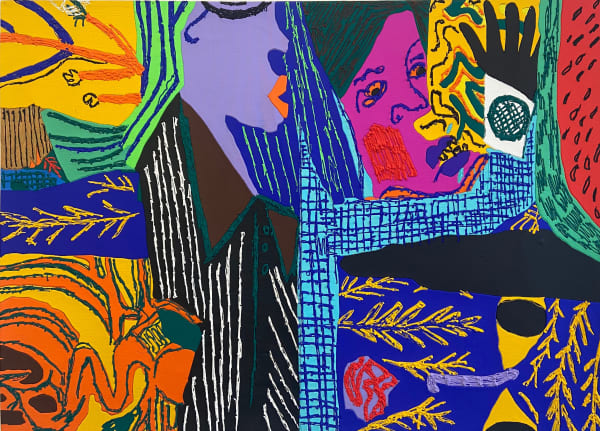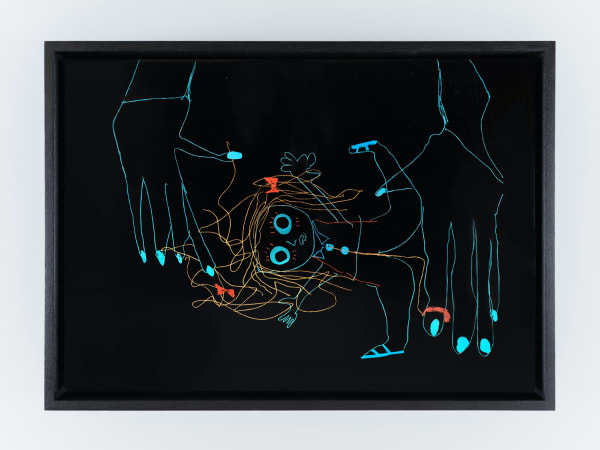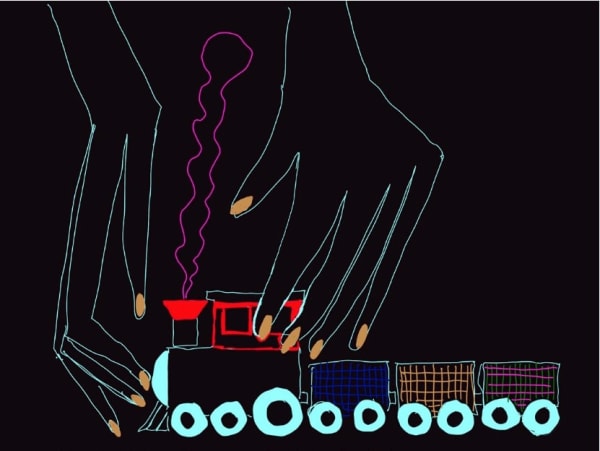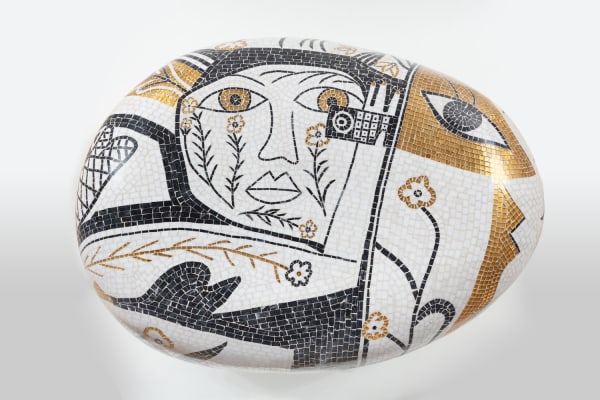Summer Wheat: Anything Can Happen
Shulamit Nazarian is pleased to present Anything Can Happen, a solo exhibition by Brooklyn-based artist Summer Wheat. This will be the artist’s second solo exhibition with the gallery.
The paintings in Anything Can Happen continue the artist’s exploration of gendered archetypes found in history, relationships to labor, and the monumentalizing of the quotidian. Expanding upon these interests, this body of work considers how the destabilization of our present moment can inspire a more wondrous experience of the everyday.
Impacted by how the fabric of society has become unmoored over the past year, Wheat’s new body of work renders our moment of absurdity with equal parts anxiety, optimism and play. In this wavering space where definitions of up and down blur, so do others: sustenance, food, care, and the body all enter a new realm of questioning what is possible. Through exploring this newfound capacity to rethink our day-to-day rules and structures, Anything Can Happen imagines a greater sense of lucidity, wonder, and possibility in an all-too-often dark world.
Consistent with past paintings, the works in Anything Can Happen look back at moments in Art History connected to labor and gender. Presenting a tradition in which women were the original healers and caretakers, Wheat reimagines historically male-dominated roles by swapping gender-specific representations in her paintings. As the artist has stated, “Popular depictions of doctors, scientists and even diagrams such as the Vitruvian Man signify our relationship to understanding the human body through a male lens. It is my interest to take passages from history and create new versions where women proliferate these roles”.
In Fruit Operation 1, Wheat reconceptualized Rembrandt van Rijn’s painting The Anatomy Lesson of Dr.Nicolaes Tulp (1632) not only with a sense of pleasure and fantasy as fruit takes the place of human organs, but as a space where women are the practitioners, experts, and academics of medicine. For Brushing Tongues, Wheat’s visual reference stems from anatomical drawings found in centuries-old Eastern and Western manuscripts. According to the artist’s research of ancient medicinal practices, the tongue acts as a road map for health by mirroring what is taking place inside the body, while literally existing at the intersection of the internal and external self. In both of these paintings, Wheat connects images of women investigating the interiority of the human form through psychologically charged renderings, making visible and equally important the inner worlds of both mind and body.
Known for their tactility and texture, Wheat’s materials take on the form of both painting and sculpture, and borrow from the rich, and often gendered, history of fibers and textiles. At first glance, the paintings appear to be beaded or woven. However, upon closer inspection, their construction is revealed as bright and malleable paint that oozes through fine wire mesh. The resulting effect is a surface that disrupts the chance for illusionistic picture making and instead champions a space where background and foreground merge and perspectives are abandoned. Fragmented and geometric figures ingest vitamins and medicine, engage in acts of self-care, and provide for one another within interwoven worlds. Through a shift in scale, the paintings throughout Anything Can Happen monumentalize moments of mothers and women in the act of healing--paying tribute to the overlooked labor of care that lies at the core of community and forms the fabric of society.
Included in this exhibition is a series of mosaic seats and works-on-panel that function as textural foils. Providing a tactile and grounding experience for the viewer, IPad, Remote Control, and Smart Phones are based on the form of river stones--smooth pebbles shaped by running water--and are adorned with hand-laid stone in the form of a mosaic. During a time of heightened virtual connection that leaves us reliant on two-dimensional screens, these seats offer a physical reminder of some of the earliest forms of storytelling and communication. Wheat has also created a new series of pigment-on-panel works, whose slick surfaces resemble that of a reflective and glowing computer tablet. In these works, a notion of touch is embodied in a child-like sense of play, depicted through hands that fumble imaginatively with toys, trains, and dolls.
Throughout history, people sought to better understand the physical body as a way to garner control against mysterious external influences. The works in Anything Can Happen bring the body into focusbyrecalling and challenging a collective past understood through images and storytelling. As the exploration of the outside world has recently been restricted, these works formulate a new investigation of our inner world: our mind, our emotions, our bodies. Proposing a new reality that is embedded with wonder, Wheat has upended the logic that typically governs us, in search of an alternative understanding of the function of our bodies and its influence on our innerselves.
-
 Summer WheatMothers, 2020Acrylic on aluminum mesh68 x 141 inches
Summer WheatMothers, 2020Acrylic on aluminum mesh68 x 141 inches -
 Summer Wheat, Cooking on the Wall, 2020
Summer Wheat, Cooking on the Wall, 2020 -
 Summer WheatFruit Operation, 2020Acrylic on aluminum mesh47 x 68 inches
Summer WheatFruit Operation, 2020Acrylic on aluminum mesh47 x 68 inches -
 Summer Wheat, Inside Out, 2020
Summer Wheat, Inside Out, 2020 -
 Summer Wheat, Internal Medicine, 2020
Summer Wheat, Internal Medicine, 2020 -
 Summer Wheat, Brushing Tongue, 2020
Summer Wheat, Brushing Tongue, 2020 -
 Summer Wheat, Fruit Operation 2, 2020
Summer Wheat, Fruit Operation 2, 2020 -
 Summer Wheat, Different Shapes and Sizes, 2020
Summer Wheat, Different Shapes and Sizes, 2020 -
 Summer Wheat, Jack in the Box, 2020
Summer Wheat, Jack in the Box, 2020 -
 Summer Wheat, Pet Dinosaur, 2020
Summer Wheat, Pet Dinosaur, 2020 -
 Summer WheatTalking Doll, 2020Pigment on wood11.7 x 16.5 inches
Summer WheatTalking Doll, 2020Pigment on wood11.7 x 16.5 inches -
 Summer Wheat, Toy Train, 2020
Summer Wheat, Toy Train, 2020 -
 Summer Wheat, IPad, white, 2020
Summer Wheat, IPad, white, 2020 -
 Summer Wheat, Smart Phones, white, 2020
Summer Wheat, Smart Phones, white, 2020 -
 Summer Wheat, Remote Control, black, 2020
Summer Wheat, Remote Control, black, 2020






















